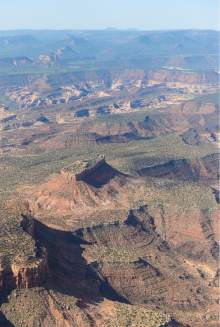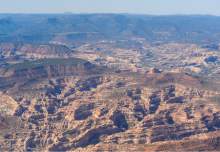This is an archived article that was published on sltrib.com in 2017, and information in the article may be outdated. It is provided only for personal research purposes and may not be reprinted.
Commenters on both sides of the Bears Ears National Monument debate say Utah's Cedar Mesa and surrounding lands should be protected, yet many remarks submitted to the Interior Department reflect intense distrust of monument proponents' intentions.
Anti-monument locals such as Ted Powell fear the 1.3 million-acre designation's real aim is to turn the region into a playground for outdoor recreation at the expense of families that have lived in San Juan County for generations.
"They want to control the area and own it for themselves," Powell wrote. "The corporate environmentalists want to control this area to make their corporations grow and increase their income. They do not care about the land, the only thing they care about is growing their company and profits.
"My prayer," he continued, "is that working together we can maximize the use of this land in this area, and have a balance of preserving ruins, preserving cattle grazing, and other commercial uses such as mining, and oil extractions."
Powell's remarks are among the more than 52,000 referencing Bears Ears submitted during a 15-day comment period that closed Friday. The vast majority urge Interior Secretary Ryan Zinke to leave the monument intact.
"I cannot think of an area more suited to designation as a national monument than Bears Ears. In time, the locals will come to understand that the designation is benefiting them economically," wrote Mary Crowe Costello, an avid hiker who has lived in Blanding for 10 years.
The public has until July 10 to submit comments on another 26 large monuments — including southern Utah's Grand Staircase-Escalante — under review across the country.
President Donald Trump instructed Zinke to make recommendations on adjusting or eliminating these monuments, starting with Bears Ears by June 10.
Many legal scholars contend presidents have no authority to strip land of monument status, while others say they can. This prospect has never been in court, which is where Bears Ears is likely headed no matter what Zinke recommends.
If the more than 100,000 comments thus far submitted is any guide, moves against these monuments would be unpopular, according to the pro-monuments Center for Western Priorities.
The group analyzed a random sample of 500 comments, half of which referenced the Bears Ears. It found just 2.8 percent called for eliminating or reducing monuments, while 96 percent urge Zinke to leave boundaries alone.
Some of the Bears Ears comments — replicated here with their original spellings as they appeared online — are soaked in emotion and personal experience.
"Its so beautiful and scenery that can take your breath away and it's beyond anyone's imaginary design, the canyon, shape of the land scape, only God or Creator make this place to exist. Please leave Bears Ears National Monument as it is," wrote one resident of the Navajo community Westwater near Blanding. "We gather our herbal to heal and use those herbal for our ceremonial, we go into those isolated area to pray and do ceremonial, that's our church per say, we hunt for our survival not for animal antlers for trophies."
But the writer's neighbors wondered instead if monument status would defile the lands, considered sacred to the five tribes that successfully petitioned President Barack Obama to set aside Bears Ears.
"When I go HOME, I don't want to go with all my city neighbors who would be going and turning the wilderness in to a parking lot to see what used to be call paradise," wrote Jody Lyman of Blanding. "Please let the local people continue to take care of their area, and not allow these extreme money hungry outdoor people to ruin one of the few real wildernesses left."
Brian Maffly covers public lands for The Salt Lake Tribune. Brian Maffly can be reached at bmaffly@sltrib.com or 801-257-8713.
Twitter: @brianmaffly





